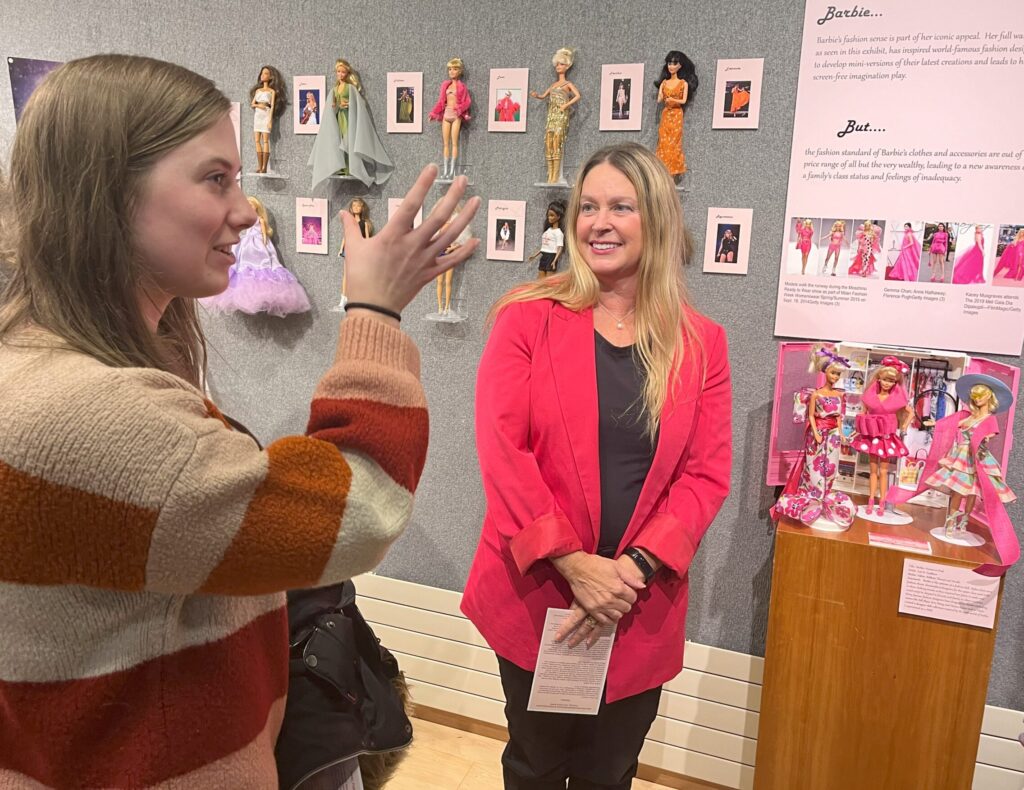Barbie and her unique history took over the Ferris Art Gallery as the new exhibit throughout the month of February.
On Feb. 15, the art gallery hosted a panel of four women to discuss Barbie. The panel featured Dr. Melissa Smith, Lori A. Faulkner, Piper Adonya and Dr. Tracy Bush. The room was filled with 60 guests including students, faculty and community members.
According to Fine Arts Gallery and Museum Director Carrie Weis, it was a wonderful and lively crowd.

Dr. Melissa Smith is an English professor and started off the panel by discussing the contradictions found in the Barbie movie and the overall controversy of Barbie as a brand.
“The problem is that not every kind of woman is represented,” Smith said during the panel. “When I was a child, Barbie was exclusively white and thin and devoid of any visible physical disabilities. Barbie as a brand has been notoriously exclusive. You can go down to the local Walmart or Meijer and find none of the curvy or wheelchaired Barbies. You’re more likely to find representation if you were a mermaid than if you use a mobility device.”
Smith concluded her speech with how this lack of representation had an impact on her childhood.
“As a child growing up, that was problematic for me. I didn’t play with Barbies because I never saw myself in the Barbies,” Smith said.
History professor Dr. Tracy Busch is the lead faculty member for Ferris’ Museum of Sexist Objects. During the panel, she discussed the white beauty ideals that Barbie represents. She also stated that she didn’t play with Barbie’s as a kid because she believed that if she was too girly, no one would take her seriously.
“When I was young, I was up in trees and playing in the dirt,” Busch said. “Barbie was an indoor doll with makeup and high heels which were not my type. It always seemed to me that Barbie’s main goal was to look good, not to actually do anything.”
Though Busch had rather negative feelings towards the doll when she was younger, she wore high heels to the panel instead of her Birkenstocks to symbolize her new appreciation for Barbie.

Kendall College of Arts and Design alumna Piper Adonya shared her stories about her childhood and what Barbie meant to her. The first Barbie she owned was Black Barbie which inspired her artwork that’s displayed in this exhibit. As a child, she felt like she didn’t belong because her ethnicity was ambiguous. But when she played with her Barbies, it was her world, and everyone fit in.
“My dad told me once, ‘God made you look the way that you do so that everyone else will feel comfortable.’ And it instilled in me this thought that what we look like matters, and what we produce matters,” Adonya said during the panel. “I can’t choose my features, but I chose my Barbies. I realized that was the first moment that I fell in love with everyone seeing themselves represented.”
As Adonya prepared for the panel, she had to think deeper about what Barbie really meant to her.
“Everyone has a Barbie story, whether you played with her or you didn’t play with her, there’s a story,” Adonya said.
Professor and chair of the KCAD fashion studies program Lori Faulkner discussed the history of how the Barbie doll came to be and how she made her way as a fashion icon. She stated that she got to cover a more light-hearted topic, fashion.
“I decided to talk about the fashion history of Barbie because we’re here in a room full of product design that has made a difference,” Faulkner said during the panel. “You can’t have Barbie without what Barbie is wearing.”
Faulkner was inspired by her mother to start her career in fashion. She created her own collection of Barbie outfits titled “Visions in Pink” which are displayed in the art gallery. These clothes for Barbie reflected the Barbie doll Faulkner had when she was a kid.
“I had one Malibu Barbie doll and that was it,” Faulkner said. “My mom wouldn’t let me get anymore because I had one. So, when I got older, I said I was going to collect all the Barbie’s and designing these outfits came full circle. I’m thinking in terms of Malibu Barbie pink everything because that was my Barbie experience.”

Sonography freshman Emily Anderson attended the event to learn more about the history of Barbie and how others viewed the toy she grew up playing with. She viewed Barbie as a role model when she was younger.
“I thought it was interesting to hear about how Barbie has influenced so many people around the world,” Anderson said. “When I was a little girl, Barbie was my favorite. I loved playing with dolls and watching all the Barbie movies. Some of the lessons Barbie taught me as a little girl continue to be an inspiration to me today. I am encouraged to follow my dreams and use my talents and passions to stand out.”
Interest and talk about Barbie have increased since Greta Gerwig’s film that came out in June 2023. Because of this, people are analyzing the Barbie movie as it runs deeper than the average pretty doll.
The Barbie exhibit will be in the Fine Arts Gallery throughout the rest of February and includes artwork from the panelists and other artists. The Gallery is open Monday through Friday from 8 a.m. to 5 p.m. in the David L. Eisler Center.
